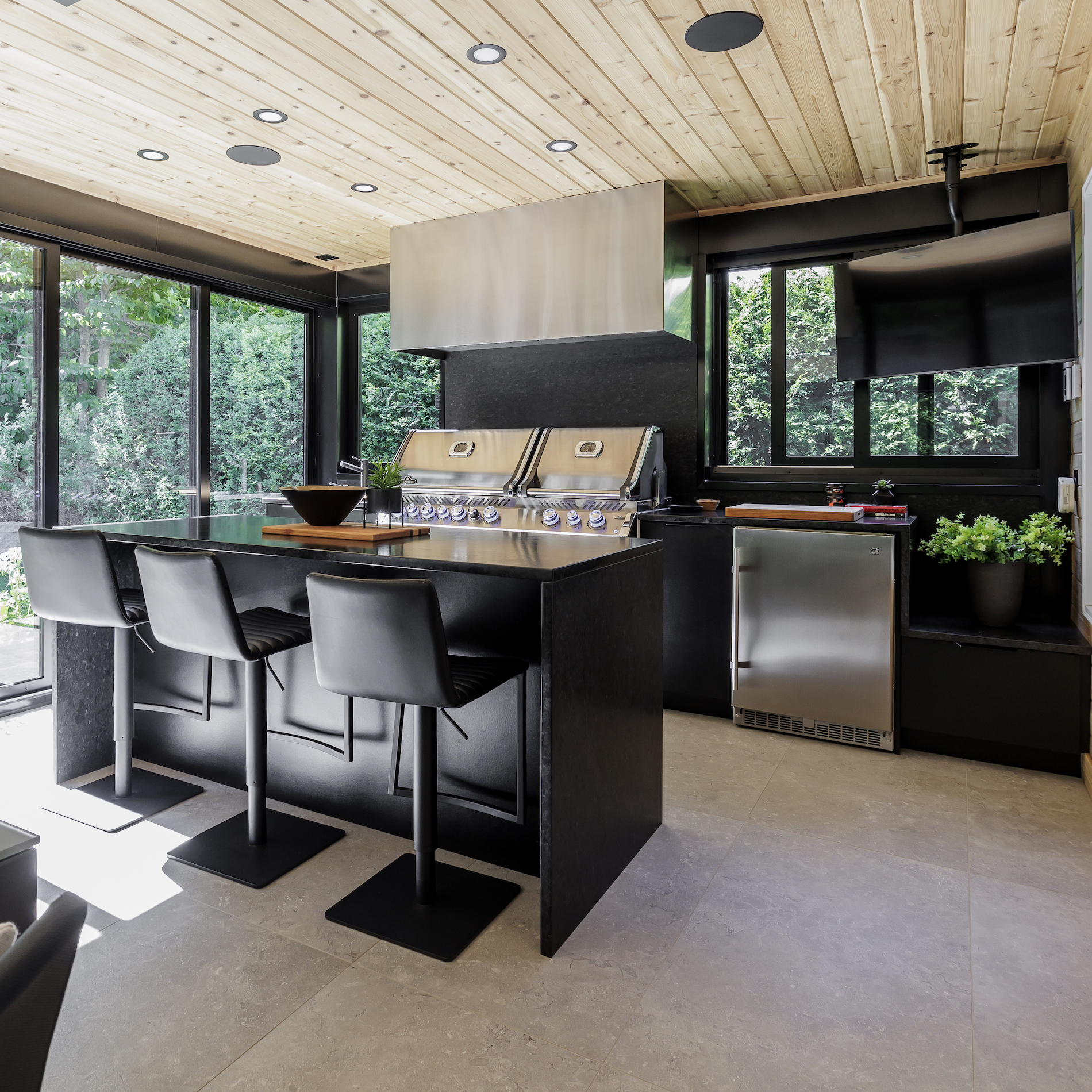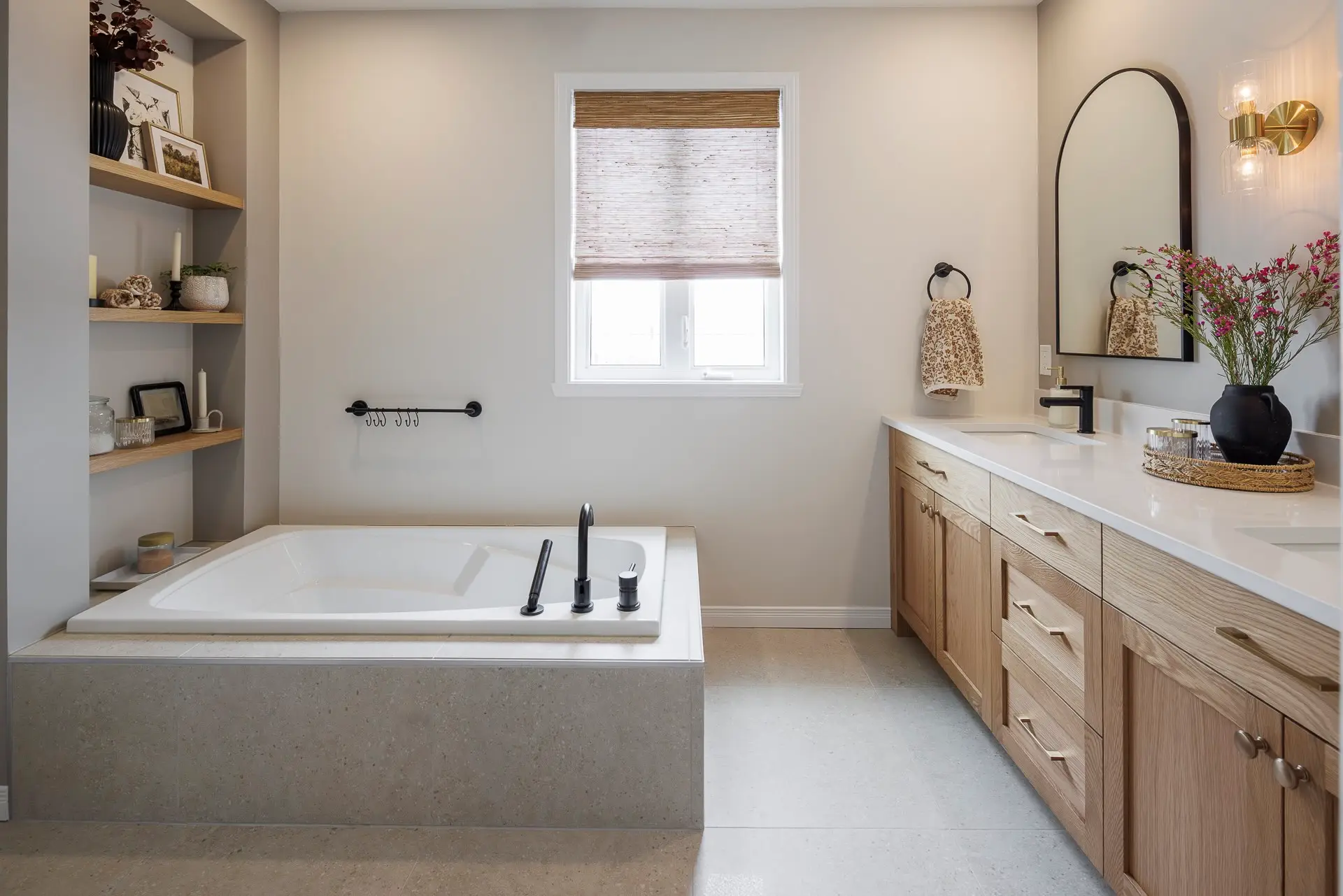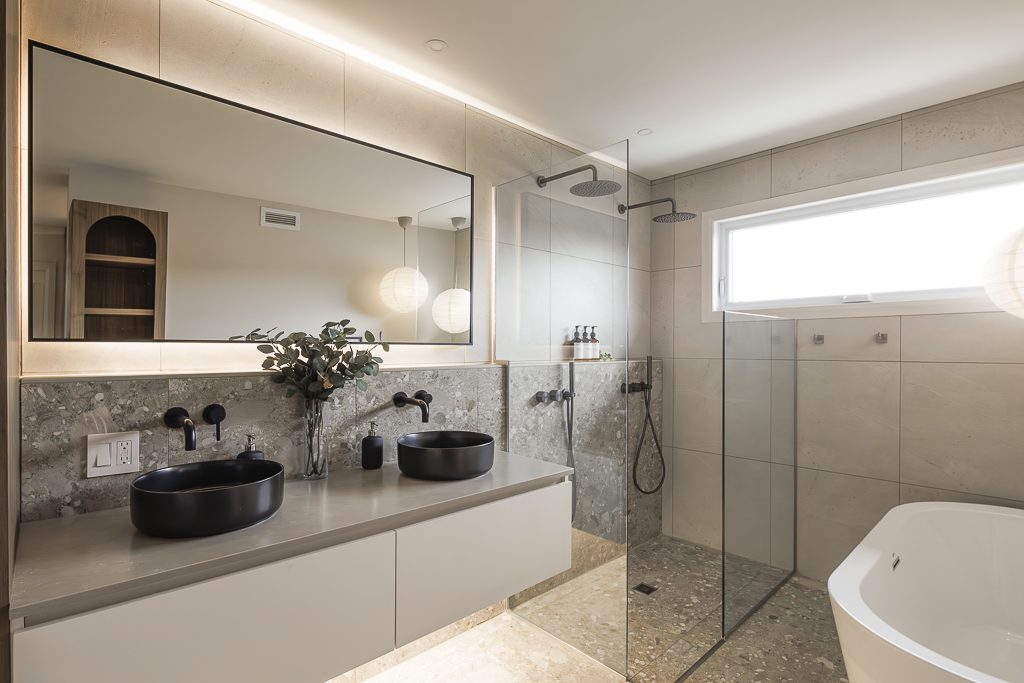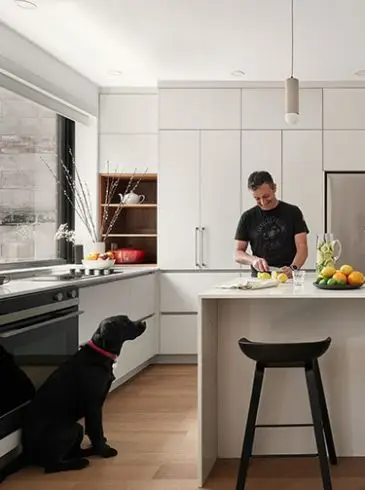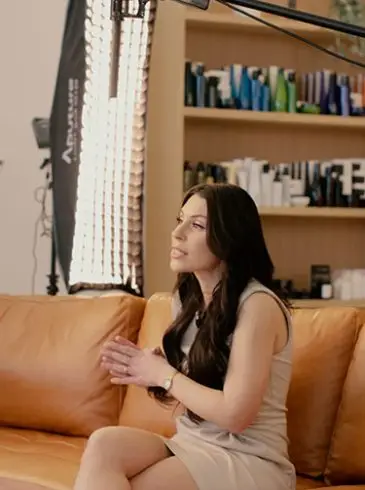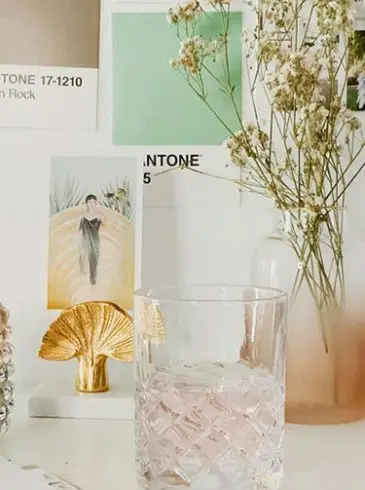Would you like to find out more about the differences between polymer vs thermoplastic cabinets, or between melamine or polyester cabinets? You have come to the right place!
ROCHON, a kitchen designer in Quebec, tells you more about the different features that each material offers and helps you decide which one is best adapted to your renovation project.
Polymer, polyester, thermoplastic or melamine cabinets: How are they made?
Each material has a specific manufacturing process. Firstly, melamine is a panel made from an agglomeration of wooden particles that are then covered with a decorative paper and resin. This resin is called melamine, which is why the panel is called the same.
Polyester is known for its appearance, which very closely mimics wood. It is mostly designed to reproduce five-piece wood doors (shaker). Polyester is made from a melamine panel and an MDF frame, covered in a polyester sheet.
As for polymer, it is a Medium-Density Fibreboard that is molded from flexible polymer particles. Polymer and Thermoplastic are very similar materials, although there are some differences in terms of properties. In fact, thermoplastic is a type of polymer that hardens or softens when heated or cooled.

The different materials and their appearance
When the time has come for you to renovate your bathroom or kitchen, design is not something you’ll want to overlook. If you want to still love your cabinets years from now, then choosing the right materials is essential, and so is the choice of color and cabinet door model.
Cabinet door materials come in a wide selection of colors. You can mix and match these colors according to the colors of your décor. Here are the different options available to you:
- Melamine is a good choice if you are looking for wood imitation. Melamine also offers several solid color options, which will allow you to mix and match colors and textures.
- When it comes to kitchen design, polymer is becoming increasingly popular. Polymer cabinets are greatly appreciated for their modern style, but also for the possibility of opting for a matte or gloss finish.
- As for thermoplastic, it comes in a wide selection of finishes. You could opt for wood imitation or a design with solid colors.
- Finally, polyester is another option for those who really want to integrate wood imitation into their design. Just like with thermoplastic, you can choose among a wide selection of solid colors. It does, however, offer less freedom when it comes to motifs or relief.
As you can see, each material offers several different designs, according to the style and finish you prefer.
Do not hesitate to find out more about the latest color trends for kitchen cabinets.

Télésphore project – Project designed by Rochon
Durability
Resistance to humidity, stains and heat are generally three of the most important features to help determine a material’s durability for kitchen cabinets.
In more general terms, polyester and polymer both offer excellent durability. Moreover, polymer is also known as a material with anti-fingerprint properties.
Resistance to Humidity
Thermoplastic is directly molded into the desired shape; this means that there is no need for edge banding, given that there are no raw materials exposed. This also translates into excellent resistance to humidity.
Generally, edge banding makes the cabinet doors less resistant to humidity and water infiltration. However, at ROCHON, we utilize a technology that offers outstanding finishes, thanks to laser-fused edge banding application. This technology ensures that the edge banding cannot come undone, making all of our cabinet doors extremely resistant to humidity.
Stain resistance
Generally speaking, all of our cabinet options are not only resistant to stains, they are also designed for an easy clean. Some materials are even more resistant to stains than others.
It is important to talk about your needs with your designer so that you can choose the perfect material for your project. For example, material recommendations will not be the same for a commercial project as it would be for use in the household.
Heat Resistance
All four abovementioned materials are resistant to indirect heat. Thermoplastic, however, can unglue under extreme heat; this means that it is important to treat it with greater care. If you are looking for an alternative that is similar but a little bit more resistant, polyester might be better suited to your needs.

Alex Harvey – Project designed by Rochon
Cabinet Maintenance
For active families, synthetic materials are an excellent choice given how easy they are to maintain. However, given that panel manufacturing techniques vary from one manufacturer to another, the quality of each product will be different. This will have a direct impact on your cabinet’s maintenance and lifespan. It is important to get the proper information from your cabinetmaker or designer, allowing you to choose the perfect product for your project.
Thermoplastic or melamine cabinets: Refacing
Refacing thermoplastic or melamine cabinets is a great way to refresh and modernize the appearance of your kitchen without needing to replace the cabinetry completely. This process typically involves covering the doors and panels with a wood veneer or other materials.
Methods of refacing
To reface a cabinet in melamine or thermoplastic, you’ll need to acquire thermoplastic sheets or laminate to cover the visible sides. These sheets might come with a self-adhesive backing or may require the use of contact adhesive.
When you begin the refacing process, all doors and pieces are removed. Next, the sheets are cut to size, glued to the surface, and a layer of varnish is applied for a flawless finish.
Pros and cons of refacing
Refacing is often favored for its affordability and quick execution. You could even purchase the materials and do it yourself, though you may achieve less satisfying results, such as the formation of bubbles.
However, refacing might not always be the best solution. If your cabinet doors are warped or damaged, it might be better to opt for resurfacing, which involves replacing the doors. If you are hesitating between thermoplastic vs melamine cabinets, remember that the latter is less likely to be deformed by heat.
To design new custom doors, we collaborate with our partner, Dörr Industries.
Cost of Cabinets: Thermoplastic vs Melamine
Price is an important element to consider when the time comes to choose the right material for your project.
Melamine and polyester are generally more affordable options, although more high-end melamine options are also available.
Polymer or thermoplastic cabinets are generally more expensive. These materials obviously offer several advantages that definitely justify a slightly higher price.
So the short answer is that the cost of remodelling a kitchen will vary greatly according to the selected materials.
What is the best material for kitchen or bathroom cabinets?
Several factors can influence your choice between polymer, polyester, thermoplastic and melamine.
Firstly, the esthetics can vary greatly for all four materials. Given that for your remodelling project, the overall look of your cabinets is an important factor to consider, it is obvious that the overall esthetics of the materials will greatly influence your final decision.
Then, the price for each option also must be taken into consideration. For example, polymer is a more expensive option. This means that if your budget is tighter, you might want to opt for melamine or polyester.
Objectively, there is no better option for your kitchen. To help you make the right decision, here is a comparison table that will help you quickly see the pros (+) and cons (-) for each of the four materials:
| Features | Melamine | Polyester | Polymer | Thermoplastic |
|---|---|---|---|---|
| Price | + | + | – | – |
| Durability | – | + | + | – |
| Resistance to Heat | + | – | – | – |
| Resistance to Humidity | – | + | + | – |
| Resistance to Stains | + | + | + | + |
| Design Options | + | – | + | – |
Frequently Asked Questions
Why is my thermoplastic cabinet peeling and what can I do about it?
Thermoplastic materials are heat sensitive, and peeling issues are commonly reported. The causes vary and need to be evaluated on a case-by-case basis. If heat warps the material, we recommend switching to polyester.
What is the typical lifespan of thermoplastic kitchen cabinets?
On average, thermoplastic cabinets last between 12 and 15 years. For greater durability, consider polymer cabinets over thermoplastic ones.
What are the advantages of refacing a thermoplastic cabinet instead of replacing it?
Refacing is less costly and can be accomplished more quickly, often within a few days. It allows you to refresh the look of your kitchen without incurring significant expenses.
For your remodelling needs in Quebec, Montreal and Gatineau, trust in ROCHON — Kitchens and Bathrooms. Our trusted partner, Gereco Construction, can help you with all of your related construction needs, like with plumbing, electricity, etc.
Contact us today for a free personal consult with a designer!


